March 2025
The global polymer concrete market size accounted for USD 617.12 million in 2024, grew to USD 655.45 million in 2025 and is expected to be worth around USD 1,127.26 million by 2034, registering a CAGR of 6.21% between 2024 and 2034. The Asia Pacific polymer concrete market size is calculated at USD 228.33 million in 2024 and is estimated to grow at a CAGR of 6.33% during the forecast period.
The global polymer concrete market size is calculated at USD 617.12 million in 2024 and is projected to surpass around USD 1,127.26 million by 2034, expanding at a CAGR of 6.21% from 2024 to 2034. Rapid urbanization and industrialization in developing countries are the key factors driving market growth. Also, increasing government investment in roads, bridges, and tunnels, along with the excellent properties of materials like durability and high strength, is expected to fuel market growth shortly.
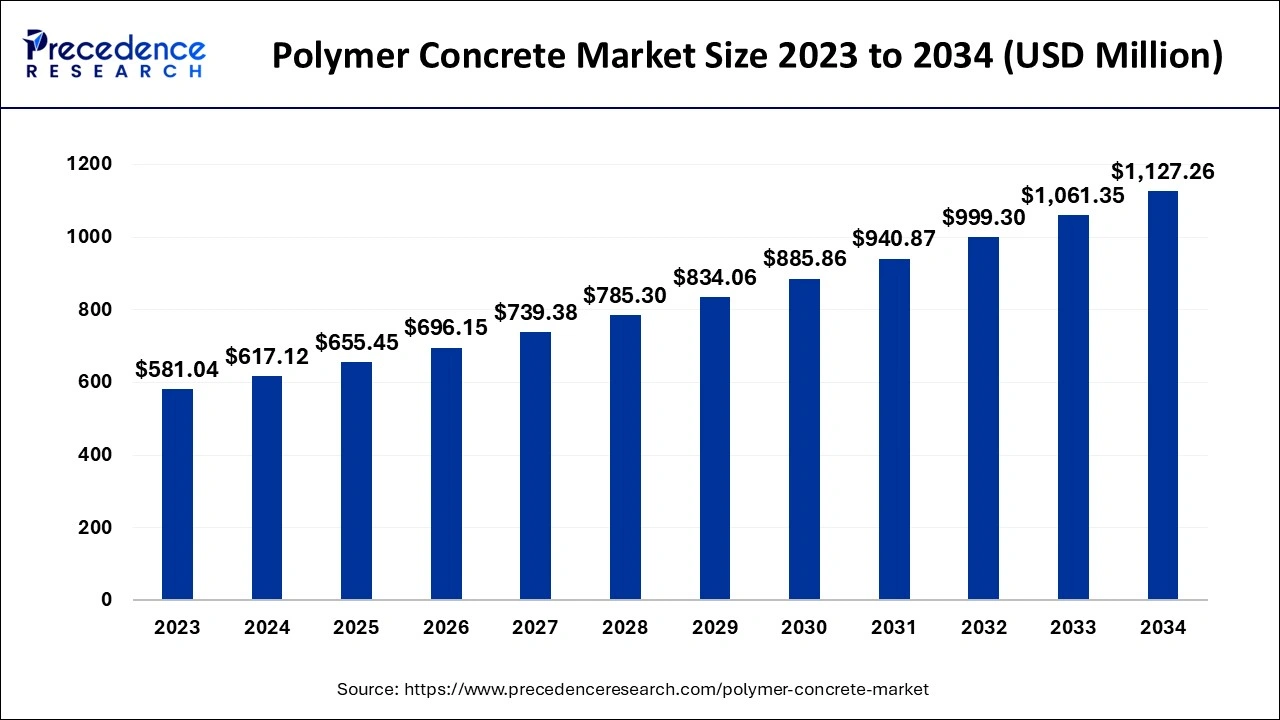
The Asia Pacific polymer concrete market size is exhibited at USD 228.33 million in 2024 and is predicted to reach around USD 422.72 million by 2034, growing at a CAGR of 6.33% from 2024 to 2034.
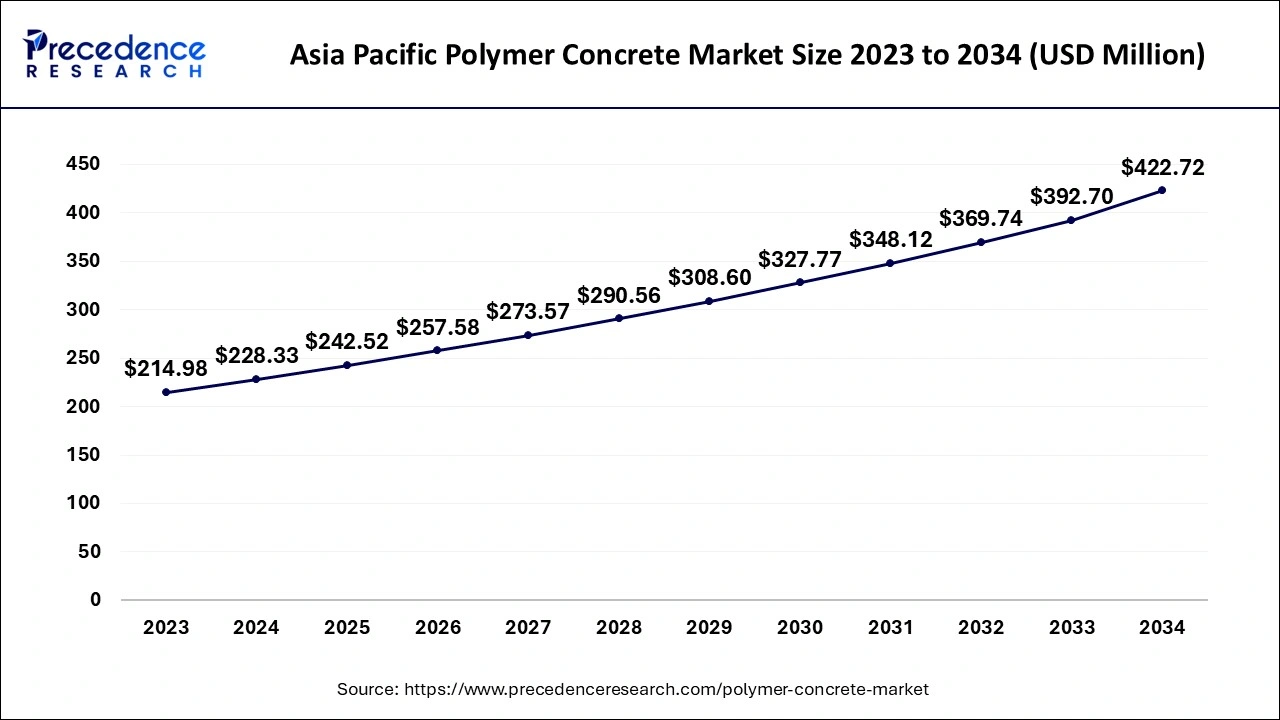
Asia Pacific led the polymer concrete market in 2023. The dominance of the region can be linked to the rising industrialization, urbanization, and infrastructure development. Countries like China and India are investing largely in infrastructure projects, like highways, tunnels, bridges, and water treatment plants. Furthermore, increasing awareness of environmental sustainability and pollution control are fueling the adoption of polymer concrete in systems, including sewer infrastructure, drainage systems, and water treatment plants in the region.
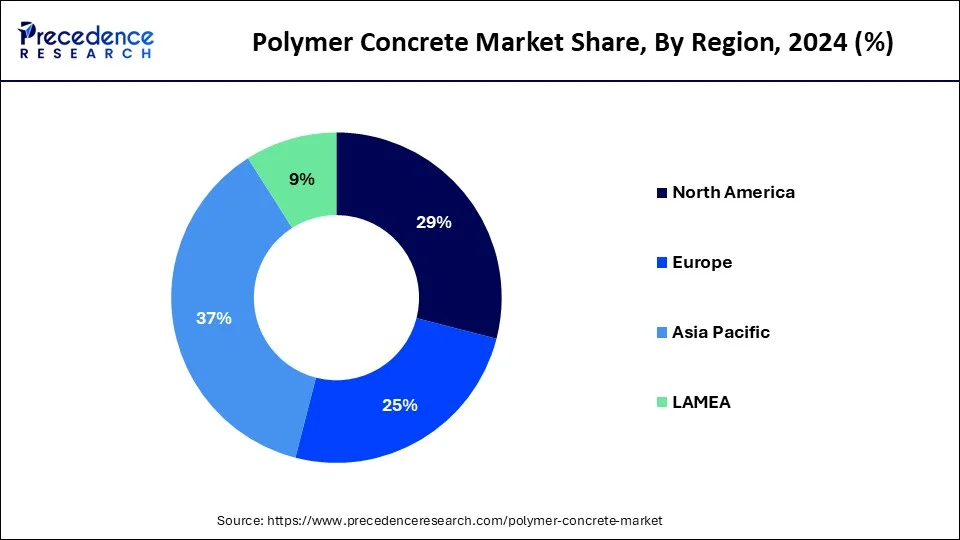
The polymer concrete market in Europe is expected to grow at the fastest rate during the projected period. The growth of the region can be attributed to the region's focus on green building practices, sustainable development, and infrastructure renovation is mainly propelling the market. Moreover, the material's long lifespan, resistance to chemicals, and low maintenance requirements make it a sophisticated option for building projects and infrastructure.
Polymer concrete is a compound created from synthetic organic polymer working as a binder. This compound is a yield of polymerization of an aggregate mixture. This monomer acts as an adhesive for the aggregates and the composite product. Portland cement is replaced completely by synthetic resin concrete or plastic resin concrete, then combined with a hardening agent, gravel, filter, and sand. Chemicals in this material have numerous properties, such as high compressive strength, high bearing strength, and low penetrability.
How AI is Transforming the Concrete Industry
Artificial Intelligence (AI) can extend its reach to managing machinery utilized in concrete production. AI-designed predictive maintenance tools can monitor the condition of machinery on a regular basis. Furthermore, AI can significantly reduce the waste generated during construction and also help in reducing excess material use and decreasing scraps. AI facilitates the utilization of substitute materials in concrete production, including aggregates or novel eco-friendly materials.
| Report Coverage | Details |
| Market Size by 2034 | USD 1,127.26 Million |
| Market Size in 2024 | USD 617.12 Million |
| Market Growth Rate from 2024 to 2034 | CAGR of 6.21% |
| Largest Market | Asia Pacific |
| Base Year | 2023 |
| Forecast Period | 2024 to 2034 |
| Segments Covered | Product Type, End Use, and Regions |
| Regions Covered | North America, Europe, Asia-Pacific, Latin America and Middle East & Africa |
The rising economic development in smart cities
The growing economy can result in the advancement of smart cities in many nations, which will increase the need for the polymer concrete market. Additionally, investment growth in public construction improves the expansion rate of the market. The increasing number of government authorities' initiatives to build underpasses, sewage, and bridges will act as a key factor impacting the growth of the market.
The growth in the number of construction activities
The growth in new developmental projects and construction activities can impact the expansion rate of the polymer concrete market. The rising popularity of polymer concrete in bridge drainage systems, nuclear power plants, and industrial plants will act as a crucial component in boosting the market expansion.
Supply chain vulnerabilities
The polymer concrete industry is susceptible to supply chain interruptions, quality difficulties, and price volatility because of its dependence on specific raw materials or suppliers. However, these risks can be decreased by creating other formulas and expanding the supplier base. Moreover, failure to keep performance restrictions like superior resistance to corrosion, abrasion, and chemicals can impede the growth of the polymer concrete market.
Growth of end-user industries
The growth of end-user industries and the surge in the need for waterproofing structures will generate beneficial opportunities for the polymer concrete market. The growing number of acquisitions and mergers among drug manufacturers in emerging economies will offer good growth among end-user industries. Furthermore, Rising knowledge among engineers and architects of the advantages of polymers, such as chemical resistance, high strength-to-weight ratio, and quicker construction, can stretch polymer concrete market growth soon.
The polymer cement concrete segment dominated the polymer concrete market in 2023. The dominance of the segment can be attributed to the rising utilization of polymer cement in renovation, repair, and new construction projects because of its cost-effectiveness and versatility. It also has good adhesion to various surfaces, making it comfortable for overlay and repair applications. The use of polymers improves the adhesion properties of the concrete to new and old surfaces. Polymer cement concrete exhibits high tensile, compressive, and flexural strength compared to conventional concrete and other polymer concrete, which makes it more suitable for heavy-duty structural use.
In 2023, the infrastructure segment led the polymer concrete market by holding the largest market share. The growth of the segment can be credited to the increasing need for low-maintenance, long-lasting materials in public works projects. Municipalities and governments leverage polymer concrete in various critical infrastructure applications like overpasses, bridges, roads, and highways. However, Infrastructure projects necessitate materials that have a long life with low maintenance. This product also provides higher resistance and longer lifespan than traditional concrete.
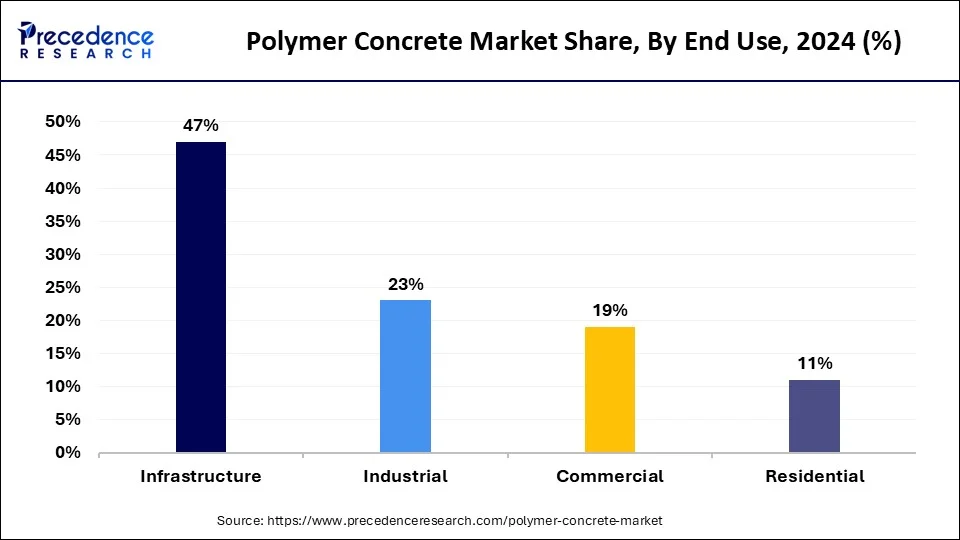
The commercial sector segment is expected to witness the fastest growth in the polymer concrete market during the forecast period. The growth of the segment can be driven by the growing use of polymer concrete in various building projects such as office buildings, hotels, retail centers, and hospitals. The material's high-performance characteristics make it suited for use in areas where wear and tear, heavy foot traffic, and chemical exposure are common. Also, the capability to mold this product in various designs is highly important in commercial architecture, especially in office and hotel buildings that need visually pleasing exteriors and interiors.
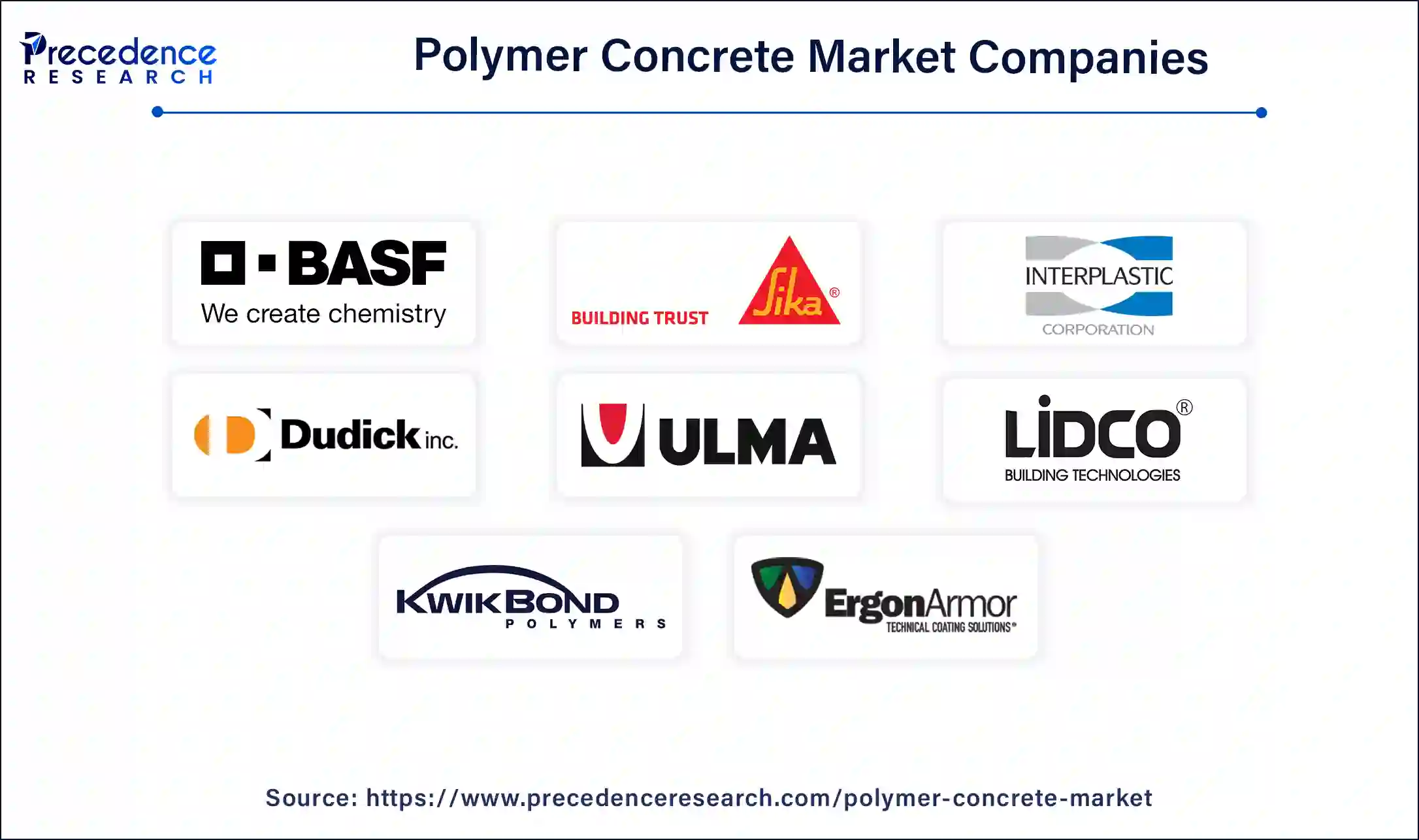
Segments Covered in The Report
By Product Type
By End Use
By Geography
For inquiries regarding discounts, bulk purchases, or customization requests, please contact us at sales@precedenceresearch.com
No cookie-cutter, only authentic analysis – take the 1st step to become a Precedence Research client
March 2025
January 2025
May 2025
May 2025